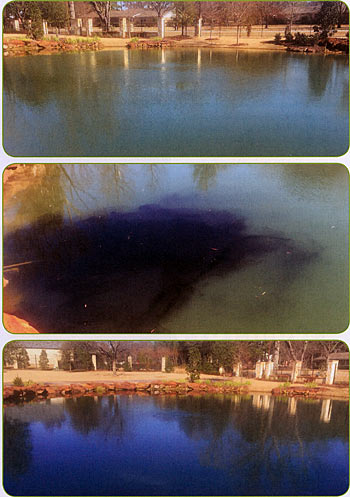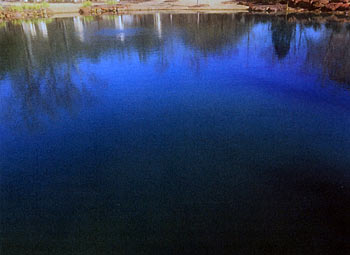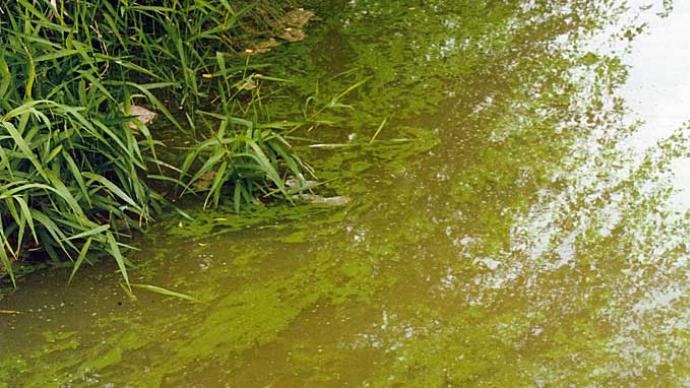
It's funny how we see things through different eyes. In January, I was traveling with some friends to a dinner date and passed a freshly dyed pond in the outskirts of the city. A lady in the vehicle with us said, "Look how pretty that pond looks! It's blue, like the Caribbean." I said, "Someone put dye in it." One of the guys said, "Looks like the Tidy-Bowl man has been swimming in it to me." Another lady, "That makes it look attractive." Another guy said, "It doesn't look natural."
All those thoughts, in less than thirty seconds.
I had a conversation the same week with a neighbor, who swears he added blue dye to one of his ponds to clear up the muddy water—and it worked.
So, what's the truth about using dye in a small pond?
The purpose of using dye in a pond is to either provide color or minimize sunlight penetration to prevent the growth of unwanted plants.
Over the years, when the topic of dyeing a pond arises in lake management conversations, the landowner is mildly surprised to learn some of the deeper effects of adding a colorant.
The spectrum of light into a pond directly affects its ability to provide life. With UV rays, plants grow. But, so does microscopic algae and plankton. When dye is added, the spectrum of light is affected. While the mission may be to prevent ugly mats of filamentous algae that disrupt enjoyment of a pond, the side effects include disrupting the food chain.
If that's okay with you, that's okay with me.
If your pond is a fishing pond, think twice about how you use dye. That's where some strategy pays off. Always remember this-— when a baby fish is first hatched, it has no stores of fat. It must eat constantly for a few days after it absorbs its yolk-sac, or it will starve. That baby fish, whatever species, has a tiny mouth, which means it needs to eat tiny food, and that's where plankton comes in. This key biological event occurs every spring, about the time water temperatures rise into the 60's. Nature moves in earnest during these key events. Fish eggs hatch, plankton is growing and reproducing rapidly. Baby fish depend on the bottom of the food chain for at least a month. Different species spawn at different temperatures, some of them overlap. When dye is added during these key months, survival rates of small fish are hampered, if not decimated.
But, we hate that filamentous algae, and if we treat it with an algaecide, doesn't that also kill microscopic algae? Yes, it does. One difference, though. Dye often lasts several weeks, even a couple of months.
So, can we use dye in our mini-pond, without affecting the lives of its inhabitants, and still help to prevent the disgusting, slimy-green algae that floats in big mats?
Yes, you can.
Don't wait until spawning season. Plan your dye use earlier in the year, before your precious fish begin to spawn. Typically, filamentous algae begins its ugly trek way before fish begin to spawn. Algae rears its head when water temperatures begin to creep into the 50's. Dye a pond when the temperatures are in the upper 40's, if you intend to use dye.

It can be effective.
As you begin to shop for dye, you'll notice there are different colors. Each color affects a different part of the spectrum of light. Read the labels, and based on your goals, make sure that color does what you want.
What about the statement my neighbor made? Said he cleared muddy water with dye. Pond dyes are inert. They have nothing but coloring. That's it. No chemical, no minerals, nothing. Just color. If a muddy pond goes clear after a dye treatment, I'd suggest something else is occurring, as there is no reaction between the dye and the mud, unlike adding gypsum, lime, or even alum. So, don't count on dye to clear up a muddy pond. It will just make the dirt change color.
Speaking of changing color, I'll always remember one of the guys who worked for me in the 80's. He was dispatched to go dye a pond on a Friday afternoon. I told him to be extra careful, as he'd not done it before. "Stay upwind, don't sling it. Wear gloves and a long-sleeve shirt, just in case." I explained how easy it is to get a few drops of dye on his skin, and that it wouldn't wash off. He listened, but didn't really understand what I was talking about. When he got back, not only was he speckled all over this arms, there was one spot about as big as a quarter on his face, and a spot on his neck where he'd rubbed himself, with dye on his hands. I shook my head when I saw him. His look was priceless. He was the best man in his best friend's wedding the next day. From then on he had a new nickname. Papa Smurf.
If you aren't concerned about a fishery in a pond, use dye all year. If you want to work with Mother Nature for the betterment of the biology of your pond, think about the timing of how you use a dye.
And, don't earn the nickname of any of the Smurf family.
Reprinted with permission from Pond Boss Magazine


